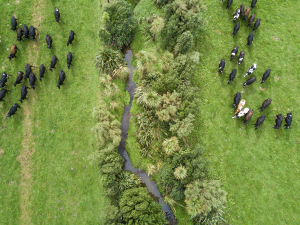Dairy farmers urged to participate in 2026 Levy vote
DairyNZ chair Tracy Brown is urging dairy farmers to participate in the 2026 Levy vote, to be held early next year.
 Throughout the Selwyn and Hinds programme, different options for reducing N loss were trialled across individual farms, depending on the needs of specific farm systems.
Throughout the Selwyn and Hinds programme, different options for reducing N loss were trialled across individual farms, depending on the needs of specific farm systems.
A DairyNZ programme to help farmers in two Canterbury catchments to reduce N loss has proved highly successful.
The programme involved 40 dairy farmers in the Selwyn and Hinds catchments started five years ago and the data shows that at least one farming couple have already met the target of reducing their N losses by 25%. That’s seven years ahead of the time frame set by government.
Overseer information shows N loss reductions of 29% from the 2017/18 season to 2021/22, and a report just released shows a continued downward trend in mean N loss per hectare from dairy farms across Canterbury – a 27.5% decrease over five years to 2021-22.
The Selwyn and Hinds programme aimed to support dairy farmers in the two catchments to meet Environment Canterbury and central government N loss reduction targets, while optimising profit and resilience. DairyNZ general manager for sustainable dairy, Dr David Burger, says the amount of change in both catchments is encouraging and shows the sector is moving in the right direction.
He says the programme has supported dairy farmers to reduce N losses by implementing solutions that work at a farm level, complementing the positive work already being done by farmers and rural professionals.
“It has also presented good opportunities for dairy farmers to share ideas and work with scientists and sector experts. Farmers have been using the information available to them to implement the best options for their farms,” he says.
Dr Burger says dairy farmers across Canterbury are improving effluent and irrigation management, reducing fertiliser use and increasing their focus on overall efficiency of farm systems, which helps reduce nitrogen being lost into groundwater.
Throughout the Selwyn and Hinds programme, different options for reducing N loss were trialled across individual farms, depending on the needs of specific farm systems.
The results and lessons were shared with other local farmers through field days and events.
Examples of effective options include crops, which are grown to contain excess nitrogen in soils that may otherwise be lost through leaching, and plantain, a low-cost, high-impact mitigation many farmers have incorporated.
The Selwyn and Hinds programme was an extension of previous DairyNZled N loss farm systems research, such as Pastoral 21 and Forage for Reduce N leaching. Many partner farms implemented several of the options identified by this previous research.
With the current situation in the European farm machinery market being described as difficult at best, it’s perhaps no surprise that the upcoming AgriSIMA 2026 agricultural machinery exhibition, scheduled for February 2026 at Paris-Nord Villepinte, has been cancelled.
The Meat Industry Association of New Zealand (MIA) has launched the first in-market activation of the refreshed Taste Pure Nature country-of-origin brand with an exclusive pop-up restaurant experience in Shanghai.
Jayna Wadsworth, daughter of the late New Zealand wicketkeeper Ken Wadsworth, has launched an auction of cricket memorabilia to raise funds for I Am Hope's youth mental health work.
As we move into the 2025/26 growing season, the Tractor and Machinery Association (TAMA) reports that the third quarter results for the year to date is showing that the stagnated tractor market of the last 18 months is showing signs of recovery.
DairyNZ chair Tracy Brown is urging dairy farmers to participate in the 2026 Levy vote, to be held early next year.
Beef + Lamb New Zealand (B+LNZ) is calling for nominations for director roles in the Eastern North Island and Southern South Island electoral districts.